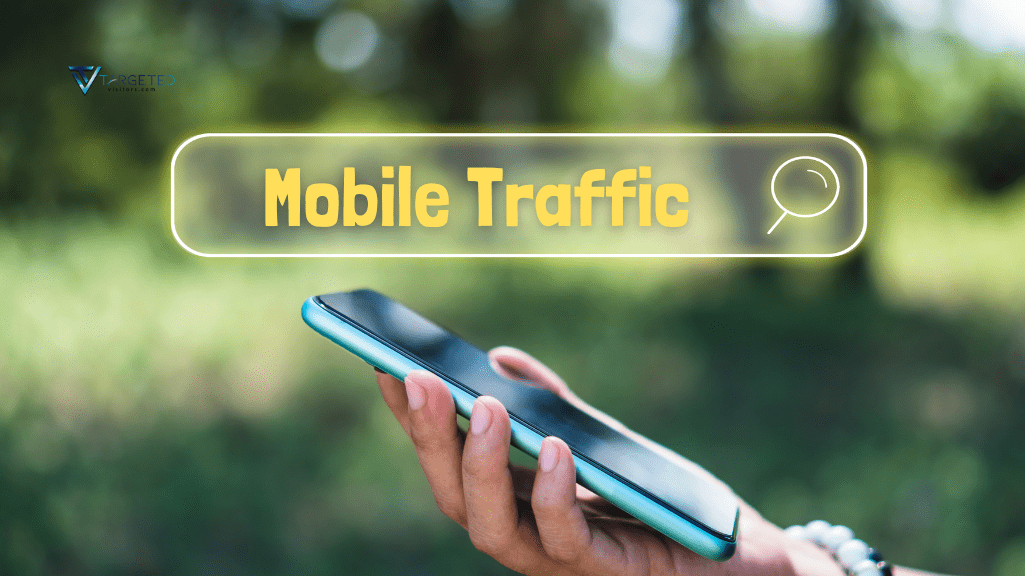Contents
- 1 Understanding Mobile Marketing and Mobile Traffic: Definition, Benefits, How It Works, and Examples
- 2 Mobile-First Strategies for Driving Traffic to Your Website
- 3 Mastering Mobile Traffic: A Comprehensive Guide
- 4 Mobile Traffic Mastery: Driving Growth and Engagement
- 5 Mastering Mobile Traffic: A Comprehensive Guide
- 5.1 Understanding the Mobile Landscape
- 5.2 Strategies for Mobile Traffic Success
- 5.3 The Role of Mobile Traffic in Overall Strategy
- 5.4 Measuring Mobile Traffic Success
- 5.5 Tracking Mobile Traffic in Google Analytics 4 (GA4)
- 5.6 Understanding Mobile Traffic in GA4
- 5.7 Key Metrics for Mobile Traffic Analysis
- 5.8 How to Track Mobile Traffic in GA4
- 5.9 Additional Tips for Mobile Traffic Analysis
Understanding Mobile Marketing and Mobile Traffic: Definition, Benefits, How It Works, and Examples
Mobile Marketing & Traffic refers to the practice of promoting products, services, or brands through mobile devices such as smartphones and tablets. This form of marketing leverages various channels and technologies to reach and engage consumers on their mobile devices. Here are some key components and strategies involved in mobile marketing:
- SMS and MMS Marketing: Sending promotional messages or multimedia content directly to users’ mobile phones via text messages.
- Mobile Apps: Creating branded mobile applications to provide value to customers, facilitate engagement, and promote products or services.
- Mobile Websites: Optimizing websites for mobile devices to ensure a seamless and user-friendly experience, which can improve search engine rankings and increase traffic.
- Mobile Advertising: Displaying ads on mobile apps, mobile websites, or social media platforms. These can include banner ads, interstitial ads, native ads, and video ads.
- Push Notifications: Sending timely and relevant notifications to users who have installed a mobile app, encouraging them to engage with the app or take specific actions.
- Location-Based Marketing: Using Geo targeted website traffic data to target users with relevant offers and promotions based on their current location.
- QR Codes: Utilizing QR codes that users can scan with their mobile devices to access special offers, information, or mobile websites.
- Social Media Marketing: Engaging with users on social media website traffic platforms through mobile-optimized content and ads.
- Email Marketing: Designing emails that are mobile-friendly to ensure they are easily readable and actionable on mobile devices.
Mobile marketing is effective because it meets consumers where they are—on their mobile devices. This approach allows businesses to reach a wider audience, provide personalized experiences, and drive higher engagement and conversions.
Mobile-First Strategies for Driving Traffic to Your Website
The Rise of Mobile Traffic
The shift towards mobile devices has been nothing short of revolutionary. With smartphones and tablets dominating internet usage, businesses that fail to adapt to this trend risk losing a substantial portion of their potential audience. Mobile traffic offers numerous advantages, including:
- Increased Reach: A mobile-optimized website expands your audience to include users on the go.
- Enhanced User Experience: Mobile-friendly design ensures seamless navigation and faster load times.
- Higher Conversion Rates: Mobile users often exhibit a higher purchase intent.
- Local Business Advantage: Mobile devices facilitate location-based searches, benefiting local businesses.
- Valuable Insights: Mobile analytics provide data on user behavior, preferences, and device usage.
Key Strategies for Mobile Traffic Success
To maximize the potential of mobile traffic, consider the following strategies:
- Responsive Web Design: Ensure your website adapts seamlessly to different screen sizes.
- Mobile-First Content Creation: Develop content tailored to mobile users, focusing on brevity and visual appeal.
- Accelerated Mobile Pages (AMP): Implement AMP for faster loading times and improved user experience.
- Local SEO Optimization: Optimize your website for local searches to attract mobile users seeking nearby businesses.
- Mobile-Friendly Calls-to-Action: Design clear and compelling CTAs for mobile users.
- User Experience Testing: Continuously test and refine your mobile website for optimal performance.
By prioritizing mobile traffic and implementing these strategies, you can unlock your website’s full potential, drive engagement, and achieve your business goals.
Mastering Mobile Traffic: A Comprehensive Guide
Mobile traffic has become a cornerstone of successful online businesses. To truly maximize its potential, focusing on targeted mobile visitors is essential. Let’s explore strategies to attract, engage, and convert this valuable audience.
Understanding Targeted Mobile Traffic
Targeted mobile traffic refers to visitors who actively seek out your products or services on their mobile devices. These users are more likely to convert into customers due to their specific intent and higher engagement levels.
Key Benefits of Targeted Mobile Traffic:
- Increased Conversions: Higher likelihood of purchases, sign-ups, or other desired actions.
- Improved ROI: Optimized spending on acquiring valuable visitors.
- Enhanced User Experience: Tailored content and design for mobile users.
- Stronger Brand Awareness: Reaching the right audience builds brand recognition.
Strategies for Attracting Targeted Mobile Traffic
- Mobile-First Optimization: Ensure your website is designed for optimal mobile experience.
- Local SEO: Optimize for local search to attract nearby mobile users.
- Mobile-Specific Content: Create content tailored to mobile users’ needs and preferences.
- Accelerated Mobile Pages (AMP): Implement AMP for faster loading times.
- Mobile Advertising: Utilize platforms like Google Ads and social media for targeted mobile ads.
- App Development: Consider developing a mobile app for deeper engagement.
- User Experience Optimization: Prioritize clear navigation, fast load times, and easy-to-use features.
The Role of Mobile Traffic in Overall Strategy
While organic traffic remains crucial, targeted mobile traffic complements it by:
- Expanding Reach: Capturing users who might not find your website through organic search.
- Accelerating Growth: Providing a quicker path to acquiring new customers.
- Enhancing Data Insights: Offering valuable information about user behavior and preferences.
By effectively leveraging targeted organic traffic (Visitors), businesses can gain a competitive edge, increase revenue, and build a loyal customer base.
Mobile Traffic Mastery: Driving Growth and Engagement
Mobile devices have transformed the way we consume content and interact with businesses. To thrive in today’s digital landscape, optimizing for mobile traffic is imperative. Let’s delve into the significance of mobile traffic and explore strategies for maximizing its potential.
The Rise of Mobile Traffic
The dominance of mobile devices in internet usage is undeniable. Key statistics highlighting this trend include:
- Global Mobile Internet Usage: Over 50% of global internet traffic originates from mobile devices.
- Mobile Commerce Growth: Mobile shopping has surged, with billions spent annually.
- Mobile Search Dominance: A majority of Google searches are conducted on mobile devices.
- Increased Mobile App Usage: Mobile apps have become integral to daily life for many.
- Mobile Video Consumption: Video consumption on mobile devices continues to skyrocket.
These statistics underscore the critical importance of a mobile-first approach for businesses across industries.
Optimizing for Mobile Success
To capitalize on mobile traffic, focus on these key strategies:
- Responsive Web Design: Ensure your website adapts seamlessly to different screen sizes.
- Mobile-Friendly Content: Create content tailored for mobile consumption, emphasizing brevity and visual appeal.
- Fast Loading Speeds: Optimize your website for quick load times on mobile devices.
- Intuitive Navigation: Simplify navigation for easy mobile browsing.
- Mobile-Specific Calls-to-Action: Design clear and compelling CTAs for mobile users.
- Local SEO: Optimize for local search to attract mobile users seeking nearby businesses.
- Mobile Advertising: Utilize mobile-specific ad formats for targeted reach.
- User Experience Testing: Continuously test and refine your mobile website for optimal performance.
Measuring Mobile Traffic Success
To gauge the impact of your mobile optimization efforts, track these key metrics:
- Mobile Bounce Rate: Assess how many visitors leave your site after viewing only one page.
- Mobile Conversion Rate: Measure the percentage of mobile visitors who complete desired actions.
- Mobile Average Session Duration: Determine how long mobile users spend on your site.
- Mobile Traffic Sources: Identify where your mobile traffic originates (search, social media, etc.).
Mastering Mobile Traffic: A Comprehensive Guide
Mobile traffic has become the cornerstone of successful online businesses. To thrive in today’s digital landscape, optimizing for mobile users is imperative. Let’s delve into strategies to attract, engage, and convert mobile visitors.
Understanding the Mobile Landscape
- Dominance of Mobile Devices: Smartphones and tablets have become primary internet access points.
- Shifting Consumer Behavior: Mobile users exhibit unique behaviors, preferences, and expectations.
- Google’s Mobile-First Index: Search engines prioritize mobile-friendly websites in rankings.
Strategies for Mobile Traffic Success
- Responsive Web Design: Ensure seamless adaptation to different screen sizes.
- Mobile-Optimized Content: Create content tailored for mobile consumption.
- Accelerated Mobile Pages (AMP): Improve page loading speed for a better user experience.
- Local SEO: Optimize for local search to attract nearby mobile users.
- Mobile Advertising: Utilize platforms like Google Ads and social media for targeted campaigns.
- User Experience Optimization: Prioritize clear navigation, fast load times, and easy-to-use features.
The Role of Mobile Traffic in Overall Strategy
- Increased Reach: Expand your audience beyond desktop users.
- Enhanced User Engagement: Mobile-friendly websites encourage longer visits and more interactions.
- Higher Conversion Rates: Optimized mobile experiences lead to more conversions.
- Improved SEO Rankings: Mobile-friendliness is a ranking factor.
- Valuable Insights: Mobile analytics provide data for informed decision-making.
Measuring Mobile Traffic Success
- Key Metrics: Track mobile bounce rate, conversion rate, average session duration, and mobile-specific goals.
- A/B Testing: Experiment with different mobile designs and content to optimize performance.
- User Feedback: Gather user feedback to identify areas for improvement.
Tracking Mobile Traffic in Google Analytics 4 (GA4)
Google Analytics 4 (GA4) offers comprehensive tools to track and analyze mobile traffic. Here’s how to effectively monitor this crucial data:
Understanding Mobile Traffic in GA4
- Device Category: GA4 categorizes traffic into desktop, mobile, and tablet devices.
- Platform: Differentiates between iOS, Android, and other platforms.
- Browser: Identifies the browser used by mobile visitors.
- Operating System: Provides insights into the operating system used by mobile devices.
Key Metrics for Mobile Traffic Analysis
- Sessions: Total number of sessions initiated from mobile devices.
- Users: Unique users accessing your website from mobile devices.
- Bounce Rate: Percentage of mobile visitors leaving your website after viewing only one page.
- Pageviews: Total number of page views generated by mobile users.
- Average Session Duration: Average time spent on your website by mobile users.
- Conversions: Number of goal completions or transactions initiated by mobile users.
How to Track Mobile Traffic in GA4
- Access the Audience Report: Navigate to the “Audience” section in GA4.
- Explore Mobile Data: Click on “Mobile” to view detailed information about mobile traffic, including device category, platform, and browser.
- Create Custom Reports: Build custom reports to analyze specific mobile user segments or compare mobile and desktop performance.
- Utilize Audience Segmentation: Create audience segments based on mobile device usage for targeted analysis.
- Leverage User Explorer: Explore individual user journeys to understand mobile user behavior in detail.
Additional Tips for Mobile Traffic Analysis
- Compare Mobile and Desktop Performance: Identify differences in user behavior and conversion rates.
- Optimize for Mobile Conversions: Track mobile-specific conversions and optimize accordingly.
- Leverage Mobile-Specific Events: Track mobile-specific events like app downloads or in-app purchases.
- Integrate with Other Data Sources: Combine GA4 data with other marketing channels for a holistic view.
Conclusion
In today’s digital landscape, the significance of mobile traffic cannot be overstated. Mastering the strategies and techniques outlined in this article will help you attract more targeted mobile visitors to your website, enhancing engagement, conversions, and long-term growth.
Key to mobile traffic mastery are a mobile-first approach, targeted traffic acquisition, strategic advertising, continuous optimization, and leveraging the impact of SERPs. Implementing these proven strategies will unlock your online presence’s full potential, keeping you ahead of the competition.
Mobile Marketing and Mobile Traffic to take the next step in your mobile traffic mastery journey, I encourage you to schedule a consultation with our team of digital marketing experts. We’ll dive deep into your unique business needs and develop a customized strategy to help you attract more mobile visitors, boost engagement, and drive sustainable growth. Click here to get started.






